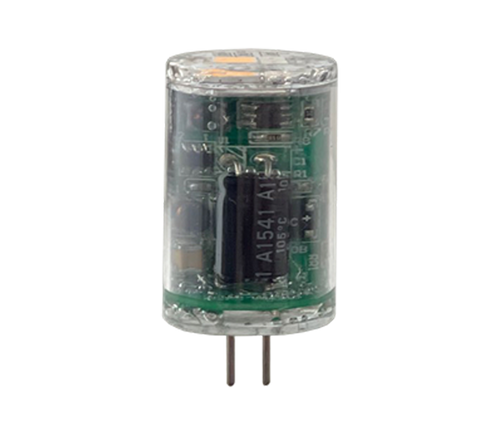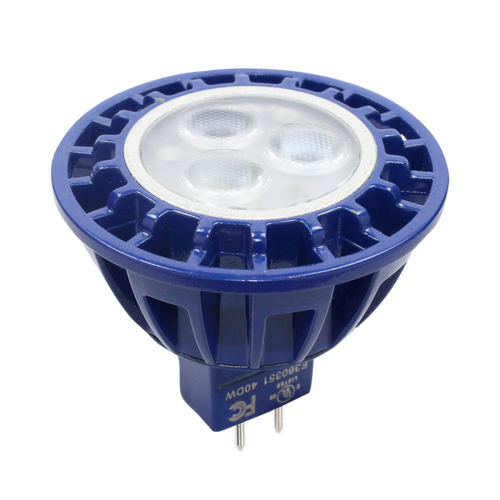Product Overview
VIVID MR16 – 5W
LED-5W-AM6FL-CCT
- 2700 – 6500k adjustable color white color temp.
- 40 degree beam
- Bluetooth controlled
Quality of LED Light
LED light is different than halogen light. Some manufacturers may tell you that they are the equivalent to halogen. They are close, but they are not exactly the same. There are two main lighting characteristics that help define the quality and consistency of LED light
CRI & CCT
Color Rendering Index (CRI) describes how a light source makes the color of an object appear to human eyes and how well subtle variations in color shades are revealed. The CRI is a scale from 0 to 100 percent indicating how accurate a “given” light source is at rendering color when compared to a “reference” light source. The higher the CRI, the better the color rendering ability. Halogen is considered the “reference” light source and has a CRI of 100.
CRI of 100 in an LED source has not yet been developed. CRI in the 90’s is possible but very expensive.
Fluorescent lamp sources are considered very poor in CRI running in the low 70’s. A CRI index >80 is considered very good. FLEX GOLD™ Series high-powered LED lamps have a CRI between 82 and 84.
Rigorous Testing
What is L70?
L70 pertains to the life expectancy of the LEDs. When CREE and other LED manufacturers project a “40,000 hour life” it is based on when an LED source deminishes light output down to a 70% light level, compared to its initial lumen output. For example if an LED starts illuminating at 100 lumens and after 40,000 hours it only emits 70 lumens (70% of the original output) then the L70 estimated life of this LED is 40,000 hours. Environmental Testing
In addition to the LED testing, the FLEX GOLD™ Series lamps have also passed extensive water/moisture, high ambient, cycling and electrical testing.
CREE LED Chips
FLEX GOLD™ Series high-powered LEDs are manufactured by the leading LED lighting manufacturer, CREE. CREE’s LED withstands the difficult and long term LM-80 testing. The LM-80 test criteria was developed by the IES and is the LED industry standard for developing the lifespan rating for LEDs. The FLEX GOLD™ Series high-powered LEDs are rated at 40,000 hours.
FLEX GOLD™ Series Thermal Management System
After an LED passes the LM-80 testing, it must also pass the LM-79 testing within the final product. This confirms that the LED is properly managed and run from a thermal standpoint. While LEDs do not give off “forward heat” like a traditional halogen source, they do get hot. If they run too hot their lifespan may be shortened. Thermal management is actually the key to their long life. The FLEX GOLD™ Series Thermal Management System controls heat and dissipates the heat away from the LED itself. The result is a very long life, even at elevated ambient temperatures that you might see in warmer climates.
Unique’s innovative FLEX GOLD™ Series LEDs offer substantial opportunities to reduce energy consumption and maintenance costs in applications where high quality light is required. Offering low cost of ownership, and with paybacks of less than 1 year in professional applications, these lamps are true retrofits that require no compromise to achieve dramatic savings.
Transformer Configuration
Understanding LEDs and Transformers
Watts and VA (Volts x Amps)
When calculating the required transformer for your installation consider the VA and not just the wattage for each FLEX GOLD™ Series lamp. While the inherent nature of LEDs is DC power, all LEDs go through a conversion factor from DC to AC. When this conversion occurs there are losses and changes to the electrical properties, this results in a “Power Factor Correction.” Unique supplies the VA for each of our lamps. For further information see individual Spec Sheets.
Primary vs. Secondary on the Transformer
The secondary side of the transformer measures the VA which includes the “Power Factor Correction.” VA are always slightly higher than the wattage that is calculated for the electric company. Always use the VA number to calculate the required transformer. Don’t forget your rule of thumb for all projects, calculate using 80% of your transformer’s maximum wattage.
VA vs. Watts Example
For a 4W MR16 FLEXGOLD™ lamp
14 fixtures x 7.1VA = 99.4 W Power load on the transformer
For a 10W PAR36 FLEXGOLD™ lamp
8 fixtures x 15.2VA = 121.6 W Power load on the transformer.







